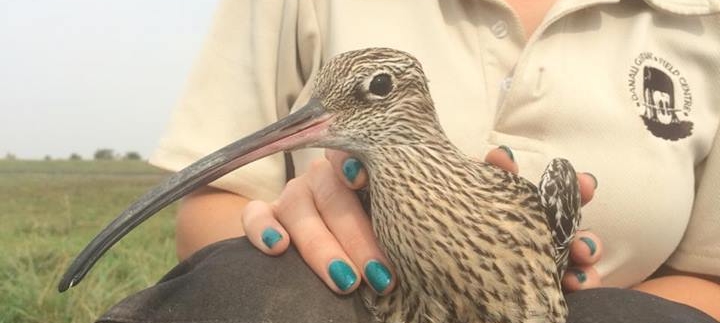Saturday 19 August
The autumn Wash week began with the combined Norfolk and Lincolnshire teams convening at the Norfolk fieldwork house on Saturday afternoon. This followed some uncertainty as to whether the planned mist netting session would be able to go ahead based on weather predictions. A recce at Gedney had taken place earlier in the afternoon with glow light markers in place for finding the way across the marsh at night. With the go-ahead agreed, the team headed off to bed for a very early start the following morning.
Sunday 20 August
Six stalwarts rose at 01:00 to set the nets whilst the remainder of the team had a lie-in until 02:30 (I maintain that these times belong to the previous evening rather than the early morning!). The birds began to go into the nets soon after the tapes were put on and birds continued to fly around the nets but the light allowed them to see, and therefore avoid, the nets. A small catch was made, limited by the fact that dawn arrived in advance of the high tide point. New members of the group had the opportunity to look at waders in the hand for the first time and to put some rings on the two new species. A lovely Whimbrel was appreciated by several members of the group with Chris winning the toss to ring it.
Catch totals:
| Species | New | Retrap | Adult | Juvenile | Total |
| Dunlin | 12 | 0 | 1 | 11 | 12 |
| Redshank | 17 | 1 | 0 | 18 | 18 |
| Whimbrel | 1 | 0 | 1 | 0 | 1 |
| Total | 30 | 1 | 2 | 29 | 31 |
Once all the birds had been ringed, processed and released the team returned to the fieldwork house for breakfast, surprised to find that it was still early morning!
Whilst the Norfolk team made plans for a catch on Snettisham Beach, Steve and Carole headed off to Lincolnshire to investigate the options for the next couple of days, collecting the shopping en route. Steve and Carole initially walked out to North Wainfleet to look for tide marks and for any evidence of a roost on the previous tide. They were reminded about the length of this walk, the creeks to be avoided and the challenges of carrying heavy equipment across the distance.
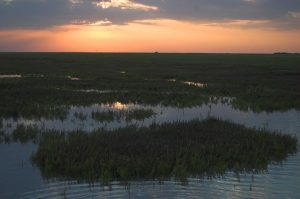
Wainfleet at sunset, by Rob Robinson
Emily Sc arrived in time to undertake high tide recces on the evening tide. Emily watched approximately 2,000 Oystercatcher at Wainfleet and identified a slightly shorter route out to Wainfleet North Island. Steve counted 150 Redshank followed by large numbers of Oystercatcher at the Horseshoe whilst Carole watched several thousand Bar-tailed Godwit south of Wrangle, all of which remained on the salt marsh. Following a relaxing meal in one of the local pubs and an early night, further recces were undertaken on Monday morning with a view to identifying a probable catch for Monday evening and some ideas for the following days.
Monday 21 August
Recces were carried out by Emily at Wainfleet, Steve at Friskney and Carole back at Wrangle where similar numbers of birds were seen as the previous evening, with a beautiful sunrise over The Wash and the morning mist rolling across the fields. Having decided where to set nets on Wainfleet North Island for a catch on Monday evening, Steve, Emily and Carole then set one net on the Horseshoe for the following morning as an insurance against an unsuccessful catch attempt this evening.
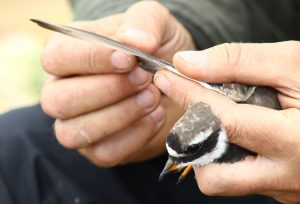
Examining a Ringed Plover, by Sam Franks
Several more of the Lincs team arrived by 13:30, in addition to several volunteers from the Norfolk team as there was no suitable catching oppoertunities in Norfolk for the evening. The team headed off for Wainfleet along Emily’s new route which she had carefully mapped to avoid encountering creeks. By 16:00, two nets were set and the team was under canvas with a three hour wait for high tide and a catch. The Oystercatcher had other ideas however and chose to roost on the wrong island. Despite valiant attempts by Will (who was marooned on his own, not quite tropical, island), the birds stubbornly refused to move and the catch was aborted with the team sprinting to the nets, not to extract the non-existent birds but to lift the nets before they were covered by the tide. Determined not to admit defeat, Emily suggested resetting a single net at the tide edge for an attempt to catch the wayward flock of Dunlin that was flying around. Having won the vote, the team supported Emily to set a net in record time, returning to their undercover retreat. Will, having returned from his island was quickly dispatched back. A bang had the team quickly running to the net for a second time to extract the three birds caught.
Catch totals:
| Species | New | Retrap | Total |
| Dunlin | 2 | 0 | 2 |
| Ringed Plover | 1 | 0 | 1 |
| Total | 3 | 0 | 3 |
The team was disappointed not to have made a larger catch and it was a long walk back to the cars, particularly for those carrying heavy equipment of cannons and nets. Will’s long vigils were rewarded with the opportunity to ring the Ringed Plover.
Tuesday 22 August
The efforts of setting the net on the Horseshoe Lagoon on Monday afternoon paid off and allowed a relatively late start to Tuesday morning, with most people in position by 06:30 and two people out on recces. The wait was rather more interesting than the previous evening, with the opportunity to watch the tide come in across the salt marsh and a very close Arctic Skua as the highlight.
Steve and the hide team observed the 700 Oystercatchers on the lagoon, which seemed surprisingly reluctant to move up to the shore and quite happy to stand in water up to their bellies. Steve estimated that there were between 30 and 50 catchable birds and a difficult decision was debated as to whether to take the catch or return in the evening when the water level in the lagoon would have risen further. The latter course was chosen and the team returned to base for breakfast.
During early morning recces, it was found that the high tide had not covered the salt marsh. Emily Sm found a flock of Curlew near Friskney; this was further explored later in the day but, although there was evidence of a roost including some very attractive Curlew feathers, the salt marsh was poached due to cattle which would make a catching attempt impossible. There was also a mixed roost of Bar-tailed Godwit and Curlew on the salt marsh further south which was considered as a possibility for the following morning so Lucy and Steve selected a suitable site for the setting of a clap net pair. Lucy was so engrossed in the process that she left her binoculars marking one of the corners! Fortunately, Lucy realised what she had done on arrival back at the base and swiftly returned to retrieve them!
A busy afternoon included Steve gaining permission to set the nets on the area of salt marsh for the catch attempt on the following morning. The landowner kindly agreed to ask the herdsman to try to move the cattle (although he was keen to assure us that they were not inquisitive). Will and Peter, who had offered to shop and mastermind a meal, found their shopping expedition to be further complicated by being asked to purchase several pairs of knickers along with the groceries! It should be noted that, although successful with the knickers, the purchase of inferior Cornflakes was not to Steve’s liking! The knickers saga highlighted the difference between experienced summer Wash trippers and rookies. When it was suggested to several of the Norfolk team that they should drive round to Lincolnshire to help with a catch, the experienced members of the team carefully packed several changes of clothing along with their toothbrushes and sleeping bag knowing that help with one catch could turn into several days!
By evening, the team found themselves once again watching the tide cover the marsh at the back of the Horseshoe Lagoon. Due to the large flock of Oystercatchers still flying over the sea wall and landing in the lagoon, the team waited a bit before getting in place behind the sea wall. The star bird this evening was a close Merlin. A catch was taken ten minutes after high tide; Steve had informed base camp that we would be making a catch of between 40 and 70 birds, a slight underestimation of the 223 birds in the net. A frenzied few minutes of lifting the birds out of the water and extracting followed. Ros made a very impressive late arrival to the team, arriving about two minutes before the firing of the cannon. All the birds were ringed and processed in good time, with the team working at maximum efficiency, and everyone was in bed by 00.30.
Catch:
| Species | New | Retrap | Total |
| Oystercatcher | 209 | 11 | 220 |
| Sanderling | 2 | 0 | 2 |
| Dunlin | 1 | 0 | 1 |
| Total | 212 | 11 | 223 |
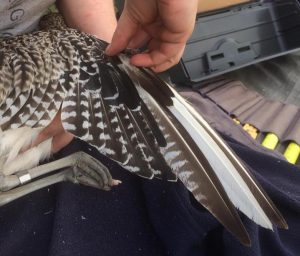
Moulting Curlew being examined, by Ros Green
Wednesday 23 August
After a meagre three and a half hours sleep, the team were up at 04:00 to set the two clap nets on the salt marsh in minimal time at first light. Two hours under canvas was then well appreciated for a bit of rest and a catch up on sleep before one of the two nets was fired at 08:10. A slight error had been made whilst setting the two clap nets in that visibility from the hide had not been fully checked for one of the nets after the location had been changed slightly. Unfortunately, it was not possible to check safety on the second net from the hide so it was only possible to fire the first net. Nevertheless a good catch of 34 Curlew was achieved.
| Species | New | Retrap | Total |
| Curlew | 31 | 3 | 34 |
| Total | 31 | 3 | 34 |
At Steve’s suggestion, the team spent a lovely hour at Wainfleet watching the swirling Knot flocks on their way to roost at Gibralter Point. As there were no good options on the Lincolnshire side for Thursday morning, and the Norfolk team had an option on the Royal Estate south of the RSPB Snettisham reserve, it was agreed that the entire team would drive to Norfolk the following morning to support the Norfolk team with their catching attempt.
Thursday 24 August
Despite an early drive from Friskney to the Sandringham Estate, the birds failed to land in the field with the nets so a catch was not made on this occasion. The views of the spiralling flock were impressive though and other highlights included seeing hares walk around one of the cars. The team then returned to the fieldwork house for breakfast and to help with the many jobs that needed doing. This included clearing the Snettisham path (along with the important task of picking blackberries) and the setting of an additional clap net pair for the following morning. The Lincolnshire team stayed for dinner (steak pie) before heading back to Friskney for the night.
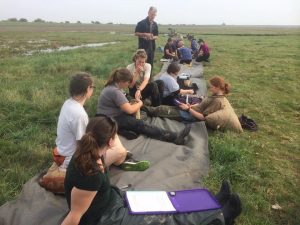
Curlew processing team
Friday 25 August
The Lincs team were up early and headed over to Sandringham, where we joined the Norfolk group and got the cars into position. A nice number of settled Bar-tailed Godwits (target species) and Curlew meant there was leeway to see if any of the large Knot flock would land. Although the murmuration was impressive, they kept to the air and the cannon nets were quickly fired once the godwits started to become more alert. A successful catch was made and the presence of both the Lincolnshire and Norfolk teams allowed for the birds to be both ringed and flagged (see Fieldwork August 2017 – Norfolk for more details).
| Species | New | Retrap | Total |
| Curlew | 33 | 5 | 38 |
| Bar-tailed Godwit | 52 | 9 | 61 |
| Knot | 2 | 0 | 2 |
| Total | 87 | 14 | 101 |
After breakfast (with Nigel’s famous eggy bread), the Lincolnshire team headed back to Friskney (arriving at 16:30 due to traffic) for a quick turnaround before heading out to Horseshoe Lagoon at 17:30 to set mist nets for the evening high tide and a cannon-net, to be used the following morning. The arrival of dinner (thank you Alex) was well timed just as everyone had finished setting and were back at base camp. The food was demolished and a Wash themed song was briefly composed. The lures were turned on once it got dark and Steve started taking people out in small groups to check the nets. Of the 65 birds caught, a real treat was the Greenshank, which was subsequently colour-ringed.
| Species | New | Retrap | Total |
| Oystercatcher | 10 | 0 | 10 |
| Knot | 1 | 0 | 1 |
| Dunlin | 15 | 0 | 15 |
| Bar-Tailed Godwit | 3 | 0 | 3 |
| Redshank | 32 | 1 | 33 |
| Turnstone | 2 | 0 | 2 |
| Greenshank | 1 | 0 | 1 |
| Total | 64 | 1 | 65 |
Saturday 26 August
The Lincolnshire team got up at a civilised hour (08:00) and then headed over to the Horseshoe Lagoon. The Oystercatchers were quite jumpy on this occasion and, with the water in the lagoon lower than the previous day, it meant the birds did not move up as far into the catching area. A successful catch was made however, allowing those less experienced in taking wader biometrics the opportunity to practice, as well as learning moult scoring.
| Species | New | Retrap | Total |
| Oystercatcher | 30 | 4 | 34 |
| Total | 30 | 4 | 34 |
There was a bit of free time in the afternoon which allowed for data checking (Alistair, Ros and Chantal), packing (for those leaving after the evening’s session), sleeping and a short game of kitties in a blender (note – no cats were harmed).
The team headed out at 17:00 to set the mist nets in an ‘E’ and an ‘I’ format across the pools on the marsh at Leverton. Our dinner arrived in a timely manner courtesy of Emily and Graham who had been to the local fish and chip shop; due to the size of the order, the shop also provided two free bottles of fizzy drink.
Later in the evening a car drove up towards basecamp; Gill managed to get them to stop before they ran over the generator and cables. Apparently, one of the locals had called the owner/person responsible for the area, as they were concerned that there may have been an illegal rave going on! Ros quickly resolved the situation by explaining who we were and that we had permission to be there. The mist netting session went well with 149 birds caught; highlights were a Whimbrel and Grey Plover.
| Species | New | Retrap | Total |
| Grey Plover | 1 | 0 | 1 |
| Knot | 1 | 0 | 1 |
| Bar-tailed Godwit | 3 | 2 | 5 |
| Redshank | 97 | 3 | 100 |
| Whimbrel | 1 | 0 | 1 |
| Dunlin | 41 | 0 | 41 |
| Total | 144 | 5 | 149 |
Sunday 27 August
The remaining people from the Lincolnshire team were up at 08:00 and quickly tidied and cleaned the Village Hall, before returning the keys and heading off for home.
Huge thanks to Steve for all his efforts and commitment in leading the Lincolnshire team and to everyone who helped with the catering. Mike and Daphne were sorely missed both for their wonderful catering skills and for their knowledge and experience of ringing on the east coast.

